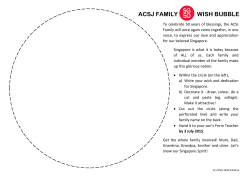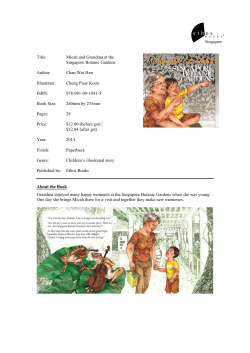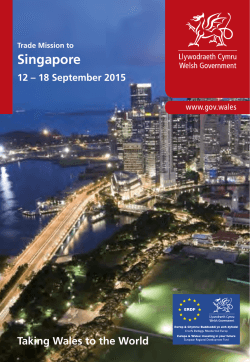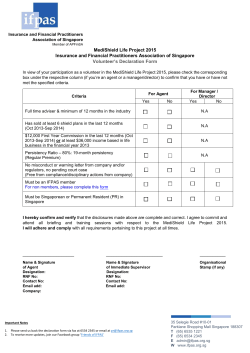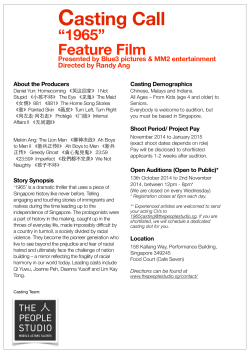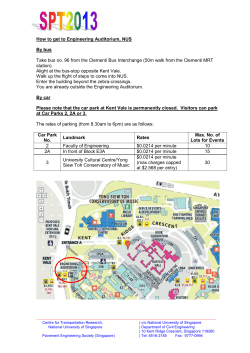
Center for Southeast Asian Studies, Kyoto University
http://englishkyoto-seas.org/ <Book Review> Loh Kah Seng Michael D. Barr. The Ruling Elite of Singapore: Networks of Power and Influence. London and New York: I. B. Tauris, 2014, 200p. Southeast Asian Studies, Vol. 4, No. 1, April 2015, pp. 216-218. How to Cite: Loh, Kah Seng. Review of The Ruling Elite of Singapore: Networks of Power and Influence by Michael D. Barr. Southeast Asian Studies, Vol. 4, No. 1, April 2015, pp. 216-218. View the table of contents for this issue: http://englishkyoto-seas.org/2015/04/vol-4-1-of-southeast-asian-studies Subscriptions: http://englishkyoto-seas.org/mailing-list/ For permissions, please send an e-mail to: english-editorial@cseas.kyoto-u.ac.jp Center for Southeast Asian Studies, Kyoto University 216 Book Reviews is usually represented in discourse as “overseas Chinese,” “Chinese diaspora,” and “Sinophone,” respectively. Tan thus cogently argues that Sinophone identities are translational, i.e. both relational and translatable, as they are formed by the coexistence of national, regional, ethnic, and local identities (p. 18). Sinophone communities, Tan underscores, assume and integrate traits from other cultures to build and rebuild their distinguishing Sinophone characteristics and thus recreate their ancestral culture (p. 41). Although resonant with previous concepts like Aihwa Ong’s “flexible identities” and Tan Chee Beng’s claim that there is no global Chinese identity, Tan goes further by critically rethinking the instrumentality of Chineseness as an effective theoretical category, especially in terms of its availability in the local context. He hence alters Chineseness to a linguistic symbol that continuously produces new meaning. In contrast to the theory of the diaspora first defined in the context of the Jewish community that focuses mainly on the notion of “returning to the original homeland,” Rethinking Chineseness reveals the mental experience of “not returning to the imaginary homeland” of diaspora Chinese. The book is significantly contributive in its scrupulous theoretical mapping of Sinophone genealogy and its detailed close-readings of the selected literary texts and practices. It skillfully investigates three writers of different generations and backgrounds, a cross-boundaries research perspective that uses impressive conceptualization and sufficient contextualization to essentially strike at the core of Sinophone notions and concerns. Although its approach is primarily rooted in literature and cultural studies, it is definitely worth reading for anyone interested in Southeast Asian studies, area studies, or Chinese studies. Chin Hsuen Wei 陳雪薇 Department of Chinese Studies, National University of Singapore The Ruling Elite of Singapore: Networks of Power and Influence MICHAEL D. BARR London and New York: I.B. Tauris, 2014, 200p. Michael Barr’s research on the recent political history of Singapore has not generally been wellreceived by Singaporean academics, to say the least. This is not surprising: Barr roundly dispatches meritocracy and multiculturalism, two basic building blocks of the Singaporean psyche, and finds instead elitism and Chinese dominance, which he traces to the work of one man, former longserving prime minister Lee Kuan Yew. Independent-minded Singaporean scholars tend to avoid attributing all things on the tiny island to one individual and to find nuances in their study of postcolonial Singapore (Hong 2002). In his latest book, Barr sets out to map the networks of power in Singapore from the 1960s Book Reviews 217 to the present. In his idea of networks, political leaders are less actors unto themselves, whose personal ambition and command of power may change the course of history, than hirelings of Lee who fulfilled his vision for piloting the city-state’s course. The networks of elitism and Chinese dominance produce a stable authoritarianism. In this sense, the book expands on Barr’s first book (2000) on Lee’s psychological make-up and the second (co-authored, 2008) on the making of Singapore as Lee envisaged. In the beginning of The Ruling Elite of Singapore, Barr cites from Lee’s memorable speech in 1966 that Singapore’s survival depended on 150 people (p. 1). The book is mainly descriptive. The first two chapters introduce the approach and argument before substantive discussions are made in the next three chapters. In Chapter 3, Barr charts the creation of an English-educated elite from the 1950s to the 1970s by a select group of People’s Action Party (PAP) leaders, among whom Lee was only the first among equals. While rival groups were crushed or co-opted in the process, Chapter 4 highlights a turning point in the 1980s when Lee attained sole power and could dictate the type of ruling elite to be recruited. Chapter 5 lays out the key aspects of Lee’s policy: the increasing emphasis on Chinese elites and elite schools, with adverse consequences for social mobility, and on male military scholarship-holders. The classic product of this process was Lee’s son, current prime minister Lee Hsien Loong, also a “retired” brigadier-general and the “uber Singaporean” (p. 91). The last three chapters of the book are generally weaker and less interesting. Chapter 6 discusses the impact of the 2011 elections on the elites: a few lost their titles but this was hardly the “bloodbath” that Barr suggested (p. 103). The last chapter predicts that even without the elder Lee, Lee Hsien Loong’s position is likely to be secure in the near future. At least Chapter 7 in between is useful in pointing out some of the failings of elite rule in Singapore and the need for a transparent government. The weaknesses of the book are apparent. As Barr himself admits, it is difficult for scholars to penetrate the walls of secrecy that enclose Singapore’s elite makers and gatekeepers (such as the work of the little-known Directorship and Consultancy Appointments Council). Barr relies mainly on official speeches and statements and on interviews with people who were part of the system. The sample of interviews, many of which are understandably anonymous, is small; what they say is important, but probably more in unraveling the claustrophobic worlds of Singaporean elites (and critics) than in depicting networks of power. Aside from a tendency to exaggerate (e.g. Goh Chok Tong’s “quasi-coup” against Lee Kuan Yew in the 1990s, p. 59), Barr deserves much credit for his sustained research into closed-off areas of Singapore history, where archival sources are limited and interviews are inflected by the experience of living under an authoritarian regime. There are important questions that Barr could have addressed in his book. For example, were all the selected elites content to play their role as handmaidens of Lee’s Singapore? Goh’s efforts to assert his independence, though trivial in comparison with political fractures in democratic and post-authoritarian countries, and the occasional 218 Book Reviews conversion of a former senior civil servant to an opposition party candidate suggest that elite formation was a more fraught and unpredictable process than Barr indicated. The book also does not explore the policy and social ramifications of the elitism. Did the recruitment of an ethnic Chinese, military-type leader affect government policy since the 1980s? In his second book, Barr examined elitism and Chinese ethnocentrism as played out in Singapore’s educational system, but there is very little discussion of their impact on government policy and their social effects in The Ruling Elite of Singapore. The book feels incomplete; one hopes that Barr would provide some answers in his subsequent research. In focusing on elitism, Barr has tackled an important and difficult subject. As he rightly notes, it is disturbing that the population has generally internalized the elitist ethos alongside their acceptance of meritocracy and multiculturalism: Singaporeans desire to succeed as part of the elite as long as it is based on endeavor and merit, no matter one’s ethnic background. However, while elitism may be dominant, it is not hegemonic. There is substantial work on the social history of Singapore that suggests that people have ways of mediating, reinterpreting, or critiquing official policy beneath the outward appearance of acquiescence (Loh 2013; Yeoh 2003; Kong and Yeoh 2003). This is possibly a way to write a more comprehensive history of elitism in Singapore that departs from Lee Kuan Yew without rejecting his considerable role. Loh Kah Seng 罗家成 Institute for East Asian Studies, Sogang University References Barr, Michael D. 2000. Lee Kuan Yew: The Beliefs behind the Man. Richmond, Surrey: Curzon. Barr, Michael D.; and Skrbiš, Zlatko. 2008. Constructing Singapore: Elitism, Ethnicity and the Nationbuilding Project. Copenhagen: NIAS Press. Hong, Lysa. 2002. The Lee Kuan Yew Story as Singapore’s History. Journal of Southeast Asian Studies 33(3): 545–557. Kong, Lily; and Yeoh, Brenda S. A. 2003. The Politics of Landscapes in Singapore: Constructions of “Nation.” Syracuse: Syracuse University Press. Loh, Kah Seng. 2013. Squatters into Citizens: The 1961 Bukit Ho Swee Fire and the Making of Modern Singapore. Singapore: NUS Press and Asian Studies of Australia Association Southeast Asia Series. Yeoh, Brenda S. A. 2003. Contesting Space in Colonial Singapore: Power Relations and the Urban Built Environment. 2nd ed. Singapore: NUS Press.
© Copyright 2025
